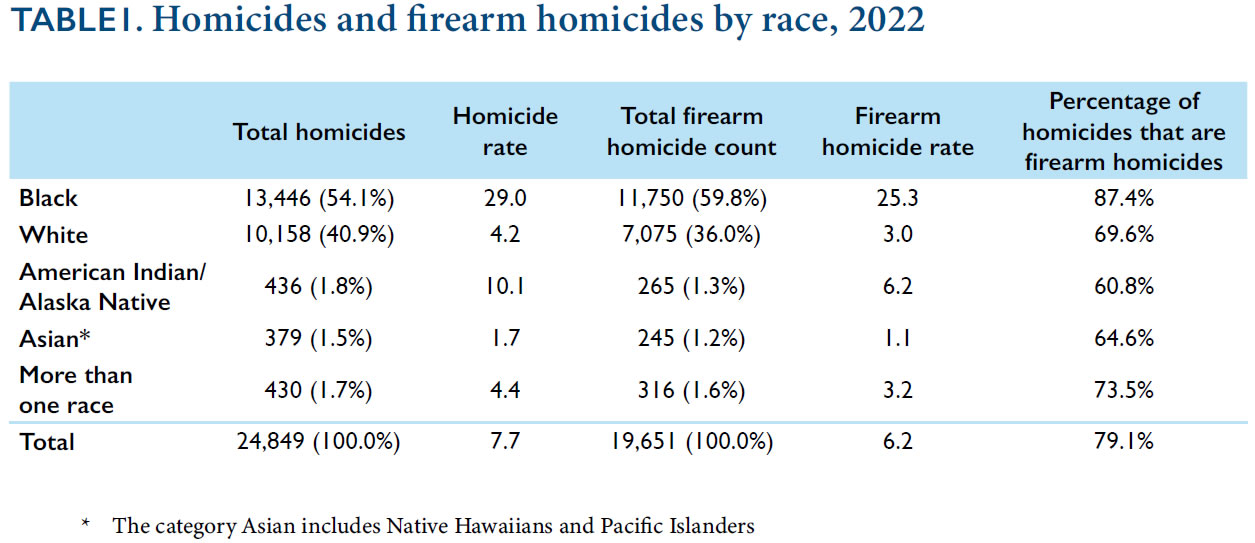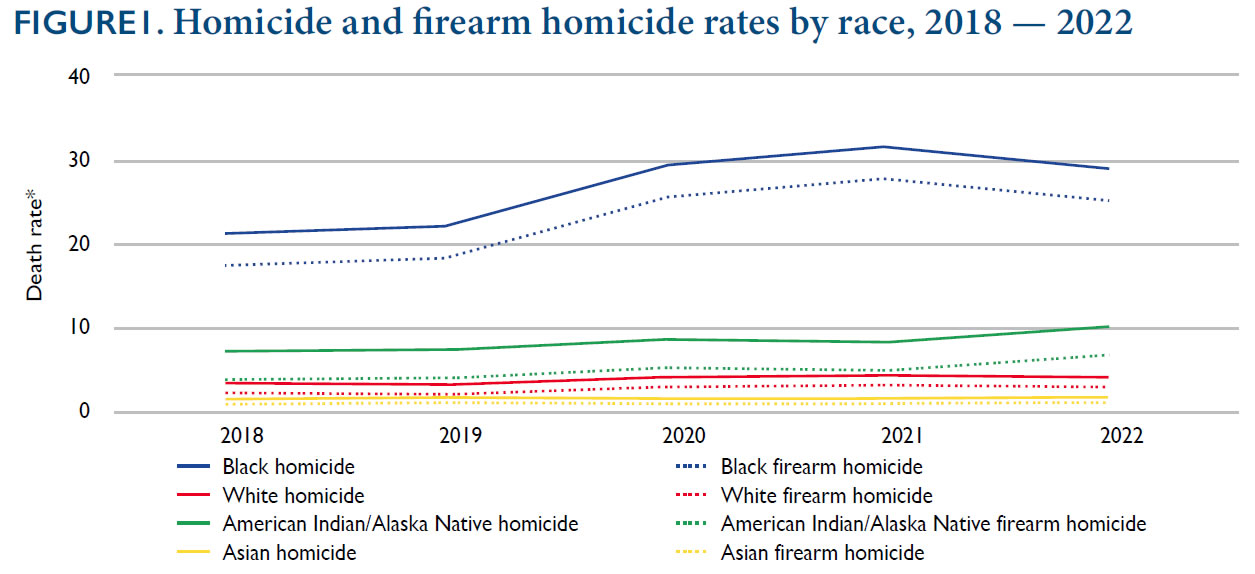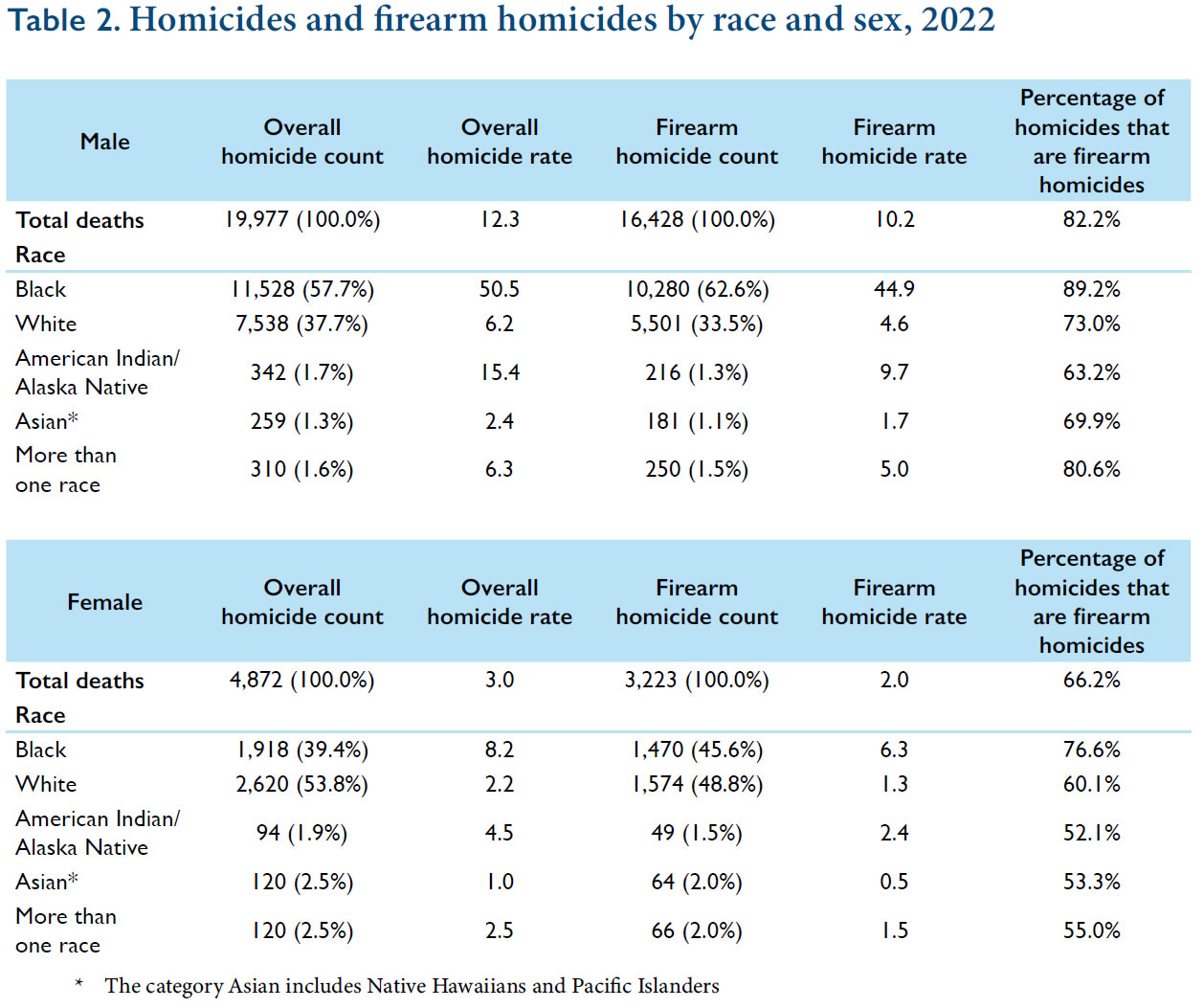National Data
According to CDC mortality data, in 2022 there were 13,446 Black homicide victims in the United States (Table 1). The homicide rate among Black victims in the United States was 29.0 per 100,000.1 For that year, the national homicide rate was 7.7 per 100,000. For white victims, the national homicide rate was 4.2 per 100,000. The Black homicide victimization rate was nearly four times the overall homicide victimization rate (29.0 per 100,000 compared to 7.7 per 100,000) and nearly seven times the white homicide victimization rate (29.0 per 100,000 compared to 4.2 per 100,000).


These racial disparities are particularly concerning when considering the racial breakdown of the United States population. While only 13.6 percent of the overall U.S. population is Black, more than half of homicide victims in 2022 were Black (54.1 percent) (Figure 2).

After increasing between 2018 and 2021, both homicide and firearm homicide rates decreased between 2021 and 2022 in the Black population (Figure 1). However, the homicide and firearm homicide rates in 2022 were substantially higher than rates in 2018 — 37 percent higher for homicide (21.2 per 100,000 in 2018 compared to 29.0 per 100,000 in 2022) and 44 percent higher for firearm homicide (17.6 per 100,000 in 2018 compared to 25.3 per 100,000 in 2022).
Sex
Of the 13,446 Black homicide victims, 11,528 (85.7 percent) were male and 1,918 (14.3 percent) were female. The homicide rate for Black male victims was more than four times the overall rate for male homicide victims (50.5 per 100,000 compared to 12.3 per 100,00) and more than eight times the rate for white male homicide victims (50.5 per 100,000 compared to 6.2 per 100,000) (Table 2). The homicide rate for Black female victims was nearly three times the overall rate for female homicide victims (8.2 per 100,000 compared to 3.0 per 100,000) and nearly four times the rate for white female homicide victims (8.2 per 100,000 compared to 2.2 per 100,000). The Black male homicide victimization rate was more than six times the Black female homicide victimization rate (50.5 per 100,000 compared to 8.2 per 100,000).

Age
Among all Black homicide victims in 2022, 1,348 were under the age of 18 (10.0 percent) and 3,271 were ages 18 to 24 (24.3 percent). Three hundred and sixty-four Black homicide victims (2.7 percent) were 65 years of age or older.
Most Common Weapons
The majority of Black homicide victims were killed with firearms (11,750 out of 13,446, 87.4 percent). Six hundred ninety-six Black homicide victims were killed with knives or other sharp instruments (5.2 percent). In comparison, 69.6 percent of white victims (7,075 out of 10,158) and 79.1 percent of all victims (19,651 out of 24,849) were killed with firearms. While the FBI’s 2022 Supplementary Homicide Report does not allow for state-by-state comparisons, it does offer information on the national level not contained in the CDC data, such as victim/offender relationship and circumstance.2
Victim/Offender Relationship
For homicides in which the victim to offender relationship could be identified, 76.5 percent of Black victims nationally (3,202 out of 4,184) were killed by someone they knew (Figure 4). Nine hundred eighty-two victims were killed by strangers (23.5 percent).

Circumstance
For homicides in which the circumstances could be identified, 80.9 percent (4,028 out of 4,977) were not related to the commission of any other felony (Figure 5). Of these, 53.9 percent (2,172 homicides) involved arguments between the victim and the offender, and 7.2 percent (291 homicides) were reported to be gang-related.

There were 81 incidents reported as justifiable homicides of Black victims killed by law enforcement in 2022. The SHR does not specifically identify killings by law enforcement that are not ruled justifiable. In January 2019, the FBI began collecting data on violent police encounters in the National Use-of-Force Data Collection database. Limited use-of-force data are currently available online. In 2023, only 11,362 out of 18,514 federal, state, local, and tribal law enforcement agencies throughout the nation participated and provided use of force data.3 The officers employed by these agencies represent 71 percent of federal, state, local, and tribal sworn officers in the nation.
Back to Table of Contents
Next – Continued Spotlight on Missouri
- All rates presented in the study are adjusted for age and per 100,000.
- FBI Supplementary Homicide Report data. Downloaded from the Crime Data Explorer on January 26, 2024. Available at: https://cde.ucr.cjis.gov/LATEST/webapp/#/pages/home.
- Federal Bureau of Investigation, Crime Data Explorer, Law Enforcement Collections. Accessed May 28, 2024. Available at: https://cde.ucr.cjis.gov/LATEST/webapp/#/pages/le/uof.






